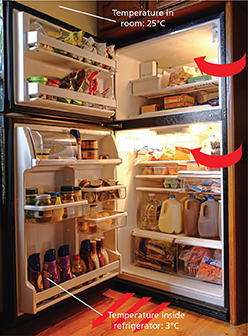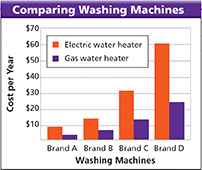Data Analysis
What Is the Real Cost of a Washing Machine?
If you ever shop for a new washing machine, you'll notice the bright yellow Energy Guide sticker on each machine. The sticker gives the machine's operating cost per year as estimated by the U.S. Department of Energy. The largest part of the cost for cleaning clothes is heating the water that goes into the washing machine. So a machine that uses less water is more efficient.
Using Graphs One family uses an electric water heater. What is their cost per year for machine A? For machine D?
Calculating How much money does this family save each year using machine A compared to using machine D?
Calculating The price of machine A is $300 more than the price of machine D. If the family uses a machine for 10 years, which one costs less overall? (Hint: Add the price to the operating cost for 10 years.)
Calculating Another family uses a gas water heater. Which machine should this family choose? Explain your thinking.
Evaluating and Revising A washing machine advertisement states that the annual cost assumes an electric water heater is used. Why would an advertisement include only this cost?
Refrigerators
A refrigerator is a heat pump— it transfers thermal energy from the cold food compartment to the warm room. To move heat from a colder to a warmer location, a motor must do work to move refrigerant through tubing inside the refrigerator walls. Could you cool your kitchen on a hot day by leaving the refrigerator door open? It might seem so, but an open refrigerator would actually heat the kitchen! You may have noticed the hot coils underneath or behind the refrigerator. The coils not only release heat absorbed from the food compartment; they also release thermal energy produced by the work the motor does. That is why a refrigerator with an open door adds more heat to the room than it removes.

What is a heat pump?

Figure 15 When a refrigerator door is open, some thermal energy from the room enters the refrigerator. But more thermal energy leaves the refrigerator through the coils underneath the food compartment.
Interpreting Photos Why can't you cool a room by leaving the refrigerator door open?





